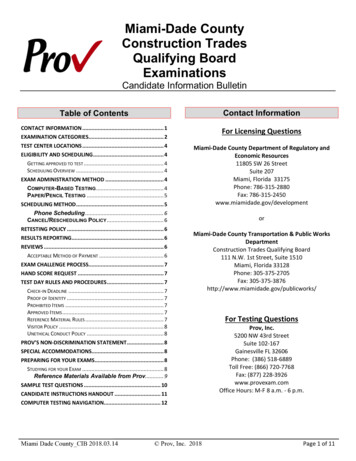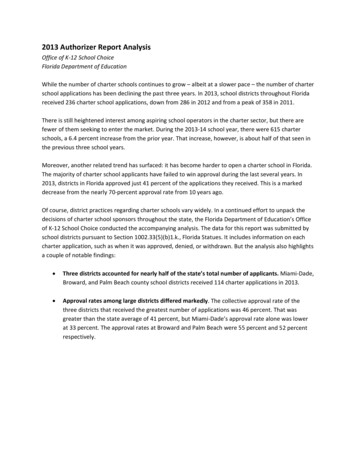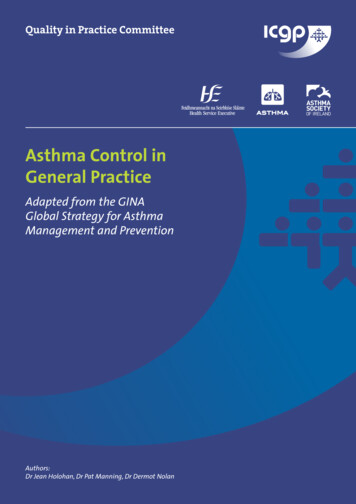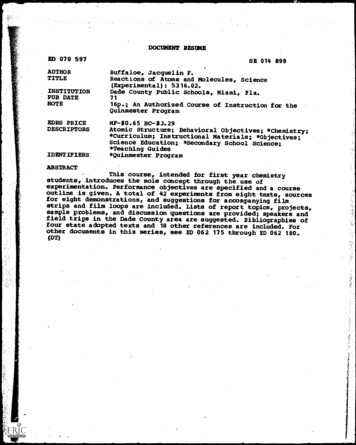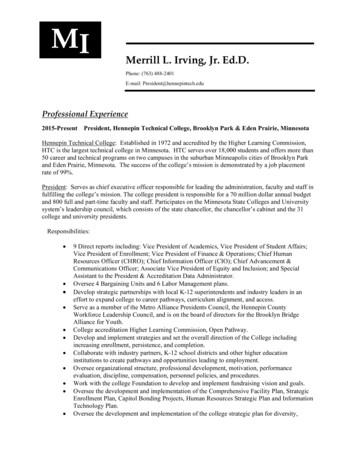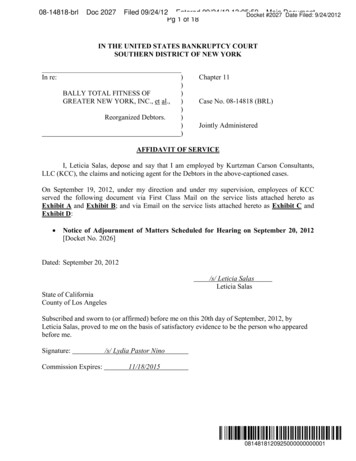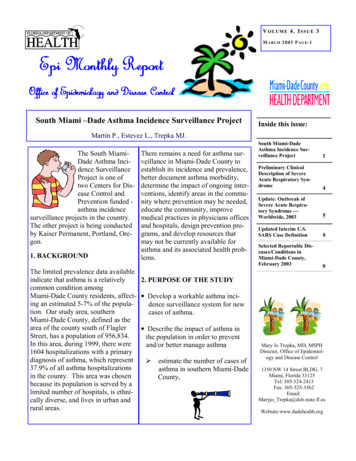
Transcription
V O L UM E 4. I S S UE 3M A R C H 2 0 03 P A GE -1South Miami –Dade Asthma Incidence Surveillance ProjectInside this issue:Martin P., Estevez L., Trepka MJ.The South MiamiDade Asthma Incidence SurveillanceProject is one oftwo Centers for Disease Control andPrevention funded asthma incidencesurveillance projects in the country.The other project is being conductedby Kaiser Permanent, Portland, Oregon.1. BACKGROUNDThere remains a need for asthma surveillance in Miami-Dade County toestablish its incidence and prevalence,better document asthma morbidity,determine the impact of ongoing interventions, identify areas in the community where prevention may be needed,educate the community, improvemedical practices in physicians officesand hospitals, design prevention programs, and develop resources thatmay not be currently available forasthma and its associated health problems.The limited prevalence data availableindicate that asthma is a relatively2. PURPOSE OF THE STUDYcommon condition amongMiami-Dade County residents, affect- Develop a workable asthma inciing an estimated 5-7% of the populadence surveillance system for newtion. Our study area, southerncases of asthma.Miami-Dade County, defined as thearea of the county south of Flagler Describe the impact of asthma inStreet, has a population of 956,834.the population in order to preventIn this area, during 1999, there wereand/or better manage asthma1604 hospitalizations with a primarydiagnosis of asthma, which representestimate the number of cases of37.9% of all asthma hospitalizationsasthma in southern Miami-Dadein the county. This area was chosenCounty,because its population is served by alimited number of hospitals, is ethnically diverse, and lives in urban andrural areas.South Miami-DadeAsthma Incidence Surveillance ProjectPreliminary ClinicalDescription of SevereAcute Respiratory Syndrome14Update: Outbreak ofSevere Acute Respiratory Syndrome --Worldwide, 20035Updated Interim U.S.SARS Case Definition8Selected Reportable Diseases/Conditions inMiami-Dade County,February 20039Mary Jo Trepka, MD, MSPHDirector, Office of Epidemiology and Disease Control1350 NW 14 Street BLDG. 7Miami, Florida 33125Tel: 305-324-2413Fax: 305-325-3562Email:Maryjo Trepka@doh.state.fl.usWebsite:www.dadehealth.org
describe demographic and risk factors,medication, health care utilization patterns,etc. in patients diagnosed with asthma, anddisseminate results to health care providers and the community.3. STUDY POPULATION Patients presenting history or symptoms ofasthma:WheezingChronic cough for at least 3 weeks.Nocturnal awakening with dyspnea,cough, wheezing. Southern Miami-Dade County. 2-64 years old; not institutionalized population.The study is being currently conducted at twoEmergency Rooms (Baptist Hospital and MiamiChildren's Hospital) and several sentinel outpatient clinics (Helen B. Bentley Community Clinic,Community Health Initiative (CHI) clinics, Pediatric Associates of Homestead, Miami Children'sMobile Clinic, Asthma Center, and Pediatric Pulmonary Center).4. OUTLINE OF THE SYSTEMhistory and utilization of health care services.The collected information regarding asthmawill be expanded with additional informationdata from abstracted medical records. Validation of case definition: pulmonologistwill review pulmonary function tests (PFT) results, questionaries data and abstracted medicalrecords data on a sample of incident case. Analysis of data: evaluate the project and disseminate results.5. DATA ANALYSISWe will determine: Incidence and prevalence rate estimates. Wewill estimate incidence and prevalence rates foradult and pediatric asthma in SouthMiami-Dade County based on all cases thatmeet the incident and prevalent asthma casedefinitions. Sample size estimate. We will calculate thesample size needed in an ongoing surveillancesystem to accurately calculate the incidence/prevalence of asthma in southern Miami-DadeCounty. Epidemiologic description. Data gatheredthrough the questionnaires and medical recordreview will be analyzed regardingdemographics, severity of disease, health careuse, asthma management and risk factors. Identification of patients: Patients with symptoms suggestive of asthma are identified atemergency departments and outpatient sites. Enrollment of candidates: Patients who want Validity of case defintion.to participate sign informed consents and complete screening questionnaire. It is a voluntarysystem. Participating patients receive healtheducation information by phone and mail. Description of asthma surveillance process:staff for asthma project will interview patientsby phone using surveillance questionnairewhich includes issues on symptomatology, severity, risk factors, medication, familyVolume 4. Issue 3March 2003Page-2
Maria E. Franco, M.D.Division of PulmonologyThe system was implemented in July 2002. To date, Rosy Roche, MSN, ARNPmore than 200 people have been enrolled. Of these,Division of Pulmonology. Cystic Fibrosis30 have incident asthma.Coordinator Gloria Riefkohl, M.D.We have made several changes to the protocol as weDivision of Preventive Medicinehave learned about barriers to enrollment. Aftercompleting the project, we will be able to provide5. Pediatric Pulmonary Center:recommendations for future surveillance efforts. Kunjana Mavunda, M.D., MPHPulmonologistWe would like to acknowledge the hard work and Marcia Prieto, RNenthusiasm of our many partners:Clinical Coordinator Patricia Catone, LPN1. Baptist Hospital:4625 Ponce de Leon Blvd. Denise Harris, RN, MSN, MBA, CNAADirector of Patient Care for Baptist Children’sHospital Christine Jerez, RN, BANDirector of Nursing Emergency Services David Wagner, BS, RRTDirector Respiratory Care Services Lisa B. Colsky, BA, RRTPerformance Improvement / Education Coordinator / Respiratory Care Erin Sewell, RRTNICU/Pediatric Respiratory SupervisorTo report diseases or for information:7. PROGRESS TO DATE2. Community Health of South Dade, Inc. (CHI): Mireya Guzman RN, MSN, MHSAVice President for Nursing Services3. Helen B. Bentley: St. Anthony Amofah, M.D.Medical Director Cynthia Carrington, R.N. MSClinical Manager James Gilligan, LCSWAsthma Counselor4. Miami Children Hospital: Maryann Henry, BS, BSN, CPN, RNAdministrative Director of Emergency andTrauma Services Rachel Chua Philotas, RN, BSNClinical Educator Emergency DepartmentOffice of Epidemiology and Disease ControlChildhood Lead Poisoning Prevention Program(305) 623-3565Hepatitis(305) 324-2490Other diseases and outbreaks(305) 324-2413HIV/AIDS Program(305) 324-2459STD Program(305) 325-3242Tuberculosis Program(305) 324-2470Special Immunization Program (305) 376-1976Nights, weekends, and holidays (305) 377-6751Volume 4. Issue 3March 2003Page-3
Preliminary Clinical Description ofSevere Acute Respiratory Syndrome[ The following article was published on MMWR, a weeklypublication by CDC [March 28, 2003 /vol. 52 / No. 12]. Thefull article can be downloaded from trointestinal findings are absent; however, somepatients have reported diarrhea during the febrileprodrome.After3--7 days, a lower respiratory phase beginswith the onset of a dry, nonproductive cough ordyspnea, which might be accompanied by or progress to hypoxemia. In 10%--20% of cases, the resSevere acute piratory illness is severe enough to require intubation and mechanical ventilation. The case-fatalityrespiratoryrate among persons with illness meeting the currentsyndrome(SARS) is a WHO case definition of SARS is approximately 3%.condition ofunknown eti- Chest radiographs might be normal during the febology thatrile prodrome and throughout the course of illness.has been de- However, in a substantial proportion of patients, thescribed in pa- respiratory phase is characterized by early focal intients interstitial infiltrates progressing to more generalized,Asia, North patchy, interstitial infiltrates. Some chest radioAmerica, and graphs from patients in the late stages of SARS alsoEurope. This have shown areas of consolidation.report summarizes the clinical description of patients with SARS based on information collectedEarly in the course of disease, the absolute lymphosince mid-February 2003 by the World Health Orcyte count is often decreased. Overall white bloodganization (WHO), Health Canada, and CDC in col- cell counts have generally been normal or decreased.laboration with health authorities and clinicians inAt the peak of the respiratory illness, approximatelyHong Kong, Taiwan, Bangkok, Singapore, the50% of patients have leukopenia and thrombocytoUnited Kingdom, Slovenia, Canada, and the United penia or low-normal platelet counts (50,000-States. This information is preliminary and limited 150,000/µL). Early in the respiratory phase, eleby the broad and necessarily nonspecific case defini- vated creatine phosphokinase levels (as high astion.3,000 IU/L) and hepatic transaminases (two to sixtimes the upper limits of normal) have been noted.As of March 21, 2003, the majority of patientsIn the majority of patients, renal function has reidentified as having SARS have been adults agedmained normal.25--70 years who were previously healthy. Fewsuspected cases of SARS have been reported amongThe severity of illness might be highly variable,children aged 15 years.ranging from mild illness to death. Although a fewclose contacts of patients with SARS haveThe incubation period for SARS is typically 2--7developed a similar illness, the majority havedays; however, isolated reports have suggested anremained well. Some close contacts have reported aincubation period as long as 10 days. The illnessbegins generally with a prodrome of fever ( 100.4 F mild, febrile illness without respiratory signs orsymptoms, suggesting the illness might not always[ 38.0 C]). Fever often is high, sometimes isassociated with chills and rigors, and might beaccompanied by other symptoms, includingVolume 4. Issue 3headache, malaise, and myalgia. At the onset ofMarch 2003Page-4illness, some persons have mild respiratorysymptoms. Typically, rash and neurologic or
progress to the respiratory phase.Treatment regimens have included severalantibiotics to presumptively treat known bacterialagents of atypical pneumonia. In several locations,therapy also has included antiviral agents such asoseltamivir or ribavirin. Steroids have also been administered orally or intravenously to patients incombination with ribavirin and other antimicrobials.At present, the most efficacious treatment regimen,if any, is unknown.In the United States, clinicians who suspect cases ofSARS are requested to report such cases to theirstate health departments. CDC requests that reportsof suspected cases from state health departments, international airlines, cruise ships, or cargo carriers bedirected to the SARS Investigative Team at the CDCEmergency Operations Center, telephone770-488-7100. Outside the United States, clinicianswho suspect cases of SARS are requested to reportsuch cases to their local public health authorities.Additional information about SARS (e.g., infectioncontrol guidance and procedures for reporting suspected cases) is available at http://www.cdc.gov/ncidod/sars. Global case counts are available athttp://www.who.int.Reported by: World Health Organization, Geneva,Switzerland. Immunization and Respiratory Infections Div, Centre for Infectious Disease Preventionand Control, Health Canada, Ottawa, Canada. CDCSARS Investigation Team; TA Clark, MD, and BPark, MD, EIS officers, CDCAcknowledgmentsThis report is based on data provided by A McGeer, MD, S Poutanen, MD,Mount Sinai Hospital, D Low, MD, Mount Sinai Hospital and Univ HealthNetwork, I Salit, MD, Univ Health Network, A Simor, MD, Sunnybrook andWomen's College Hospital, Univ of Toronto; S Finkelstein, MD, ScrarboroughGrace Hospital, B Henry, MD, Toronto Public Health, Toronto; W Bowie,MD, E Bryce, MD, K Craig, MD, P Doyle, MD, J Ronco, MD, F Ryan, MD,Univ of British Columbia and Vancouver Hospital and Health Sciences Center, L Srour, MD, British Columbia Centre for Disease Control, Vancouver,Canada. S Chang, MD, Y Chen, MD, P Shueh, MD, G Chen, MD, B Kuo, MD,National Taiwan Univ Hospital, Taipei; S Chen, MD, Ilan Hospital, Ilan; MLiin, MD, Chia-Yi Christian Hospital, Chia-Yi; T Chen, MD, L Lee, MD, STwu, MD, Taiwan Center for Disease Control, Taipei, Taiwan. S Tansuphaswadikul, MD, V Pinyowiwat, MD, J Wongsawat, MD, Bamrasnaradura Institute, Nonthaburi, Thailand.Update: Outbreak of Severe AcuteRespiratory Syndrome -- Worldwide,2003[ The following article was selected from CDC MMWR .March 28, 2003/52(12);241-248. The full article can bedownloaded from htm]United States. As ofMarch 26, CDC has received 51 reports of suspected SARS cases from21 states (Table), identifiedusing the CDC updated interim case definition (Box).The first suspected casewas identified on March15, in a man aged 53 years who traveled to Singapore and became ill on March 10. Four clusters ofsuspected cases have been identified, three of whichinvolved a traveler who had visited Southeast Asia(including Guangdong province, Hong Kong, orVietnam) and a single family contact. One of theseclusters involved suspected cases in patients L andM who had stayed together at hotel M during March1-6, when other hotel guests were symptomatic. Patient L became sick on March 13 after returning tothe United States. His wife, patient M, became illseveral days after the onset of her husband's symptoms, suggesting secondary transmission. Three patients in the United States with suspected SARS(patients I, L, and M) reported staying at hotel Mwhen other persons staying in the hotel were symptomatic. The fourth cluster began with a suspectedcase in a person who traveled in Guangdong province and Hong Kong. Two HCWs subsequently became ill at the U.S. hospital where this patient wasadmitted.Volume 4. Issue 3March 2003Page-5
Laboratory investigations. On March 24,CDC announced that laboratory analysis hadidentified a previously unrecognized coronavirus in patients with suspected or probableSARS. The new coronavirus was isolated inVero E6 cells from clinical specimens of twopatients in Thailand and with suspected SARS.The isolate was identified initially as a coronavirusby electron microscopy (EM) (Figure 3).The identity was corroborated by results of immunostaining, indirect immunofluorescence antibody (IFA) assays, and reverse transcriptasepolymerase chain reaction (RT-PCR) with sequencing of a segment of the polymerase gene.IFA testing of sera and RT-PCR analysis ofclinical specimens from six other SARS caseswere positive for the new coronavirus. Coronavirus particles also were identified by EM incells obtained by bronchial lavage from a patientwith SARS. Sequence analysis suggests thatthis new agent is distinct from other knowncoronaviruses. Other laboratories collaboratingin the WHO-led investigation have found similar results and also have isolated a different virus, human metapneumovirus, from some patients with suspected SARS. Information is insufficient to determine what roles these two viruses might play in the etiology of SARS.Reported by:T Tsang, T Lai-Yin, L Pak-Yin, M Lee, Dept ofHealth, Hong Kong. J-S Wu, Y-C Wu, I-HChiang, K-T Chen, K-H Hsu, T-J Chen, Taiwan Center for Disease Control; L-T Lee, S-JTwu, Taiwan Dept of Health, Taiwan. S Chunsuttiwat, P Sawanpanyalert, K Ungchusak, AChaovavanich, Ministry of Public Health,Thailand. Ministry of Health of Vietnam, WHOSARS Investigative Team, Vietnam. CDC SARSInvestigative Team, SL Roy, MD, EIS Officer,CDCReferences1. DC. Outbreak of severe acute respiratorysyndrome--worldwide, 2003. MMWR2003;52:226--8.2. World Health Organization. Cumulativenumber of reported cases (SARS). Available at http://www.who.int/csr/sarscountry/2003 03 26/en.3. World Health Organization. Case definitions for surveillance of severe acuterespiratory syndrome (SARS). Available at http://www.who.int/csr/sarscasedefinition/en.4. Health Canada. Epidemiology, clinicalpresentation and laboratory investigation of severe acute respiratory syndrome (SARS) in Canada, March 2003.Available at tc/03vol29/prev/dr-sars0325.html.Volume 4. Issue 3March 2003Page-6
5.McIntosh K. Coronaviruses. In: Mandell GL, Ben- 8. Ijaz MK, Brunner AH, Sattar SA, Nair RC, Johnnett JE, Dolin R, eds. Mandell, Douglas, and Benson-Lussenburg CM. Survival characteristics ofnett's Principles and Practice of Infectious Disairborne human coronavirus 229E. J Gen Viroleases, 5th ed. Philadelphia: Churchill Livingstone,1985;66:2743--8.Inc., 2000.9. CDC. Updated interim domestic infection control6. Sizun J, Yu MWN, Talbot PJ. Survival of humanguidance in the health care and community settingcoronaviruses 229E and OC43 in suspension afterfor patients with suspected SARS. Available atdrying on surfaces: a possible source of ntrol.acquired infections. J Hosp Infect 2000;46:55--60.htm.7. Ijaz MK, Brunner AH, Sattar SA, NairRC, Johnson-Lussenburg CM. Survivalcharacteristics of airborne human coronavirus 229E. J Gen Virol1985;66:2743- - 8.10. Institute of Medicine. Microbial Threats to Health:Emergence, Detection, and Response. SmolinskiMS, Hamburg MA, Lederberg J, eds. WashingtonDC: The National Academies Press, 2003. Available at http://www.nap.edu/ books/030908864X/html .Volume 4. Issue 3March 2003Page-7
[ The following article was selected from CDC March 28, 2003 The full article can bedownloaded from If you have any patients that youthink may meet the case definition,please notify the Office of Epidemiology and Disease Control Program: during working hours(305)-324-1413after hours, weekends, and holidays(305)-377-6751Frequently Asked QuestionsDownload PDF version formatted for printhttp://www.cdc.gov/ncidod/sars/faq.htmMarch 28, 2003Volume 4. Issue 3March 2003Page-8
Monthly ReportSelected Reportable Diseases/Conditions in Miami-Dade County, February eriosisChancroidChlamydia trachomatisCiguatera . coli , O157:H7E. coli , OtherEncephalitisGiardiasis, AcuteGonorrheaGranuloma InguinaleHaemophilus influenzae B (invasive)Hepatitis AHepatitis BHIV *ProvisionalLead PoisoningLegionnaire's DiseaseLeptospirosisLyme diseaseLymphogranuloma VenereumMalariaMeaslesMeningitis (except aseptic)Meningococcal DiseaseMumpsPertussisPolioRabies, AnimalRubellaSalmonellosisShigellosisStreptococcus pneumoniae, Drug ResistantSyphilis, InfectiousSyphilis, 003this 6119101720032002200120001999Year to Date Year to Date Year to Date Year to Date Year to 02455500000005000008311251350028* Data on AIDS are provisional at the county level and are subject to edit checks by state and federal agencies.** Data on tuberculosis are provisional at the county level.Volume 4. Issue 3March 013162121880010
asthma in southern Miami-Dade County, South Miami -Dade Asthma Incidence Surveillance Project Martin P., Estevez L., Trepka MJ. Mary Jo Trepka, MD, MSPH Director, Office of Epidemiol-ogy and Disease Control 1350 NW 14 Street BLDG. 7 Miami, Florida 33125 Tel: 305-324-2413 Fax: 305-325-3562 Email: Maryjo_Trepka@doh.state.fl.us

